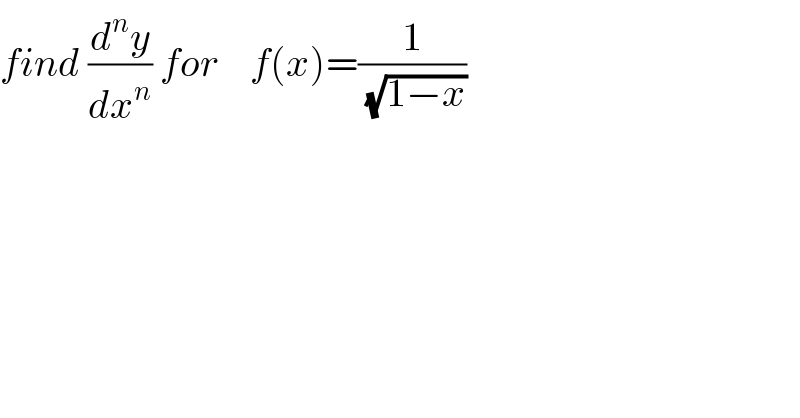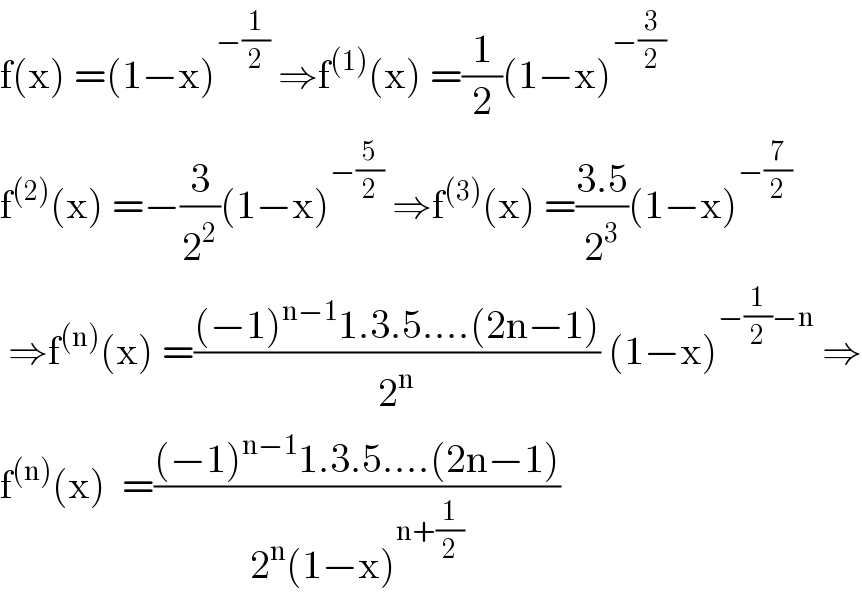Question Number 104783 by 175mohamed last updated on 23/Jul/20

$${find}\:\frac{{d}^{{n}} {y}}{{dx}^{{n}} }\:{for}\:\:\:\:{f}\left({x}\overset{} {\right)}=\frac{\mathrm{1}}{\:\sqrt{\mathrm{1}−{x}}} \\ $$
Answered by Dwaipayan Shikari last updated on 23/Jul/20

$${f}\left({x}\right)=\frac{\mathrm{1}}{\:\sqrt{\mathrm{1}−{x}}} \\ $$$${f}^{'} \left({x}\right)=\frac{\mathrm{1}}{\mathrm{2}}\:\frac{\mathrm{1}}{\left(\mathrm{1}−{x}\right)^{\frac{\mathrm{3}}{\mathrm{2}}} } \\ $$$${f}''\left({x}\right)=\frac{\mathrm{3}}{\mathrm{4}}\:\frac{\mathrm{1}}{\left(\mathrm{1}−{x}\right)^{\frac{\mathrm{5}}{\mathrm{2}}} } \\ $$$${f}'''\left({x}\right)=\frac{\mathrm{15}}{\mathrm{8}}\:\frac{\mathrm{1}}{\left(\mathrm{1}−{x}\right)^{\frac{\mathrm{7}}{\mathrm{2}}} } \\ $$$${f}^{\:{n}} \left({x}\right)=\frac{\underset{{n}=\mathrm{1}} {\overset{{n}} {\prod}}\left(\mathrm{2}{n}−\mathrm{1}\right)}{\mathrm{2}^{{n}} }\:\frac{\mathrm{1}}{\left(\mathrm{1}−{x}\right)^{{n}+\frac{\mathrm{1}}{\mathrm{2}}} } \\ $$
Answered by mathmax by abdo last updated on 24/Jul/20

$$\mathrm{f}\left(\mathrm{x}\right)\:=\left(\mathrm{1}−\mathrm{x}\right)^{−\frac{\mathrm{1}}{\mathrm{2}}} \:\Rightarrow\mathrm{f}^{\left(\mathrm{1}\right)} \left(\mathrm{x}\right)\:=\frac{\mathrm{1}}{\mathrm{2}}\left(\mathrm{1}−\mathrm{x}\right)^{−\frac{\mathrm{3}}{\mathrm{2}}} \\ $$$$\mathrm{f}^{\left(\mathrm{2}\right)} \left(\mathrm{x}\right)\:=−\frac{\mathrm{3}}{\mathrm{2}^{\mathrm{2}} }\left(\mathrm{1}−\mathrm{x}\right)^{−\frac{\mathrm{5}}{\mathrm{2}}} \:\Rightarrow\mathrm{f}^{\left(\mathrm{3}\right)} \left(\mathrm{x}\right)\:=\frac{\mathrm{3}.\mathrm{5}}{\mathrm{2}^{\mathrm{3}} }\left(\mathrm{1}−\mathrm{x}\right)^{−\frac{\mathrm{7}}{\mathrm{2}}} \\ $$$$\:\Rightarrow\mathrm{f}^{\left(\mathrm{n}\right)} \left(\mathrm{x}\right)\:=\frac{\left(−\mathrm{1}\right)^{\mathrm{n}−\mathrm{1}} \mathrm{1}.\mathrm{3}.\mathrm{5}….\left(\mathrm{2n}−\mathrm{1}\right)}{\mathrm{2}^{\mathrm{n}} }\:\left(\mathrm{1}−\mathrm{x}\right)^{−\frac{\mathrm{1}}{\mathrm{2}}−\mathrm{n}} \:\Rightarrow \\ $$$$\mathrm{f}^{\left(\mathrm{n}\right)} \left(\mathrm{x}\right)\:\:=\frac{\left(−\mathrm{1}\right)^{\mathrm{n}−\mathrm{1}} \mathrm{1}.\mathrm{3}.\mathrm{5}….\left(\mathrm{2n}−\mathrm{1}\right)}{\mathrm{2}^{\mathrm{n}} \left(\mathrm{1}−\mathrm{x}\right)^{\mathrm{n}+\frac{\mathrm{1}}{\mathrm{2}}} } \\ $$
Commented by bubugne last updated on 24/Jul/20

$${why}\:\left(−\mathrm{1}\right)^{{n}−\mathrm{1}} \:? \\ $$
Commented by abdomathmax last updated on 24/Jul/20

$$\mathrm{the}\:\mathrm{sign}\:\mathrm{of}\:\mathrm{f}^{\left(\mathrm{n}\right)} \mathrm{changes}…. \\ $$
Commented by bubugne last updated on 25/Jul/20

$$\mathrm{Does}\:\mathrm{the}\:\mathrm{sign}\:\mathrm{of}\:\mathrm{f}^{\left(\mathrm{n}\right)} \:\mathrm{change}? \\ $$$${f}\left({x}\right)=\left(\mathrm{1}−{x}\right)^{−\frac{\mathrm{1}}{\mathrm{2}}} \:\Rightarrow\:{f}^{\left(\mathrm{1}\right)} \left({x}\right)=\left(−\mathrm{1}\right)\left(−\frac{\mathrm{1}}{\mathrm{2}}\right)\left(\mathrm{1}−{x}\right)^{−\frac{\mathrm{3}}{\mathrm{2}}} \\ $$$${f}^{\left(\mathrm{1}\right)} \left({x}\right)=\:+\:\frac{\mathrm{1}}{\mathrm{2}}\:\left(\mathrm{1}−{x}\right)^{−\frac{\mathrm{3}}{\mathrm{2}}} \:\Rightarrow\:{f}^{\left(\mathrm{2}\right)} \left({x}\right)=\:\frac{\mathrm{1}}{\mathrm{2}}\:\left(−\mathrm{1}\right)\left(−\frac{\mathrm{3}}{\mathrm{2}}\right)\left(\mathrm{1}−{x}\overset{−\frac{\mathrm{5}}{\mathrm{2}}} {\right)} \\ $$$${f}^{\left(\mathrm{2}\right)} \left({x}\right)=\:+\:\frac{\mathrm{3}}{\mathrm{4}}\:\left(\mathrm{1}−{x}\overset{−\frac{\mathrm{5}}{\mathrm{2}}} {\right)}\Rightarrow\:{f}^{\left(\mathrm{3}\right)} \left({x}\right)=\:\frac{\mathrm{3}}{\mathrm{4}}\:\left(−\mathrm{1}\right)\left(−\frac{\mathrm{5}}{\mathrm{2}}\right)\left(\mathrm{1}−{x}\right)^{−\frac{\mathrm{7}}{\mathrm{2}}} \\ $$$${f}^{\left(\mathrm{3}\right)} \left({x}\right)=\:+\:\frac{\mathrm{15}}{\mathrm{8}}\:\left(\mathrm{1}−{x}\right)^{−\frac{\mathrm{7}}{\mathrm{2}}} \\ $$$${f}^{\left({n}\right)} \left({x}\right)\:=\:+\:\frac{\underset{{k}=\mathrm{1}} {\overset{{n}} {\prod}}\left(\mathrm{2}{k}−\mathrm{1}\right)}{\mathrm{2}^{{n}} }\:\left(\mathrm{1}−{x}\right)^{−\frac{\mathrm{2}{n}+\mathrm{1}}{\mathrm{2}}} \\ $$
